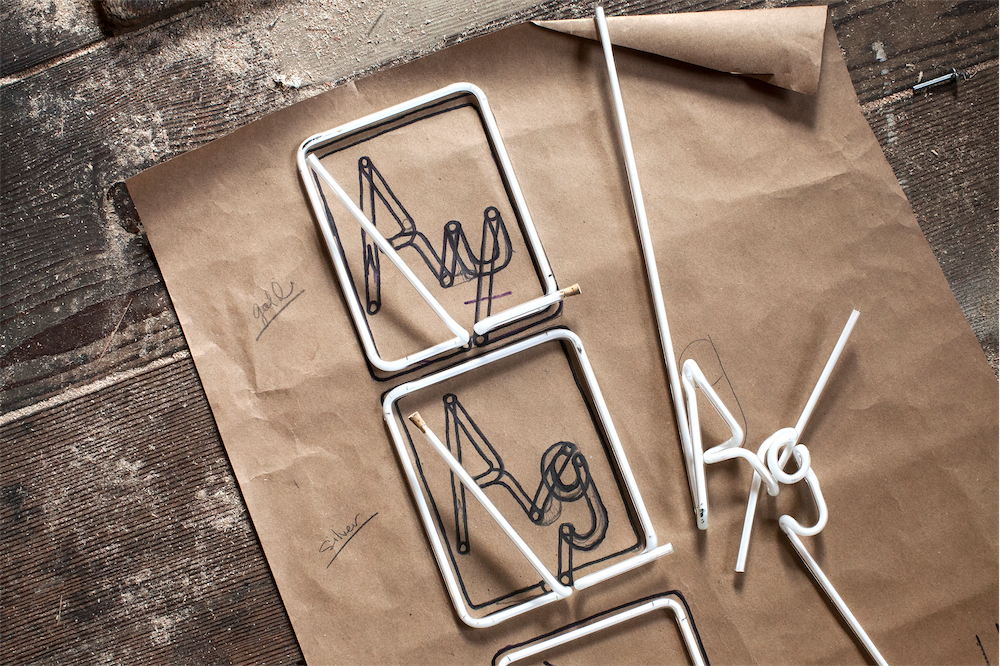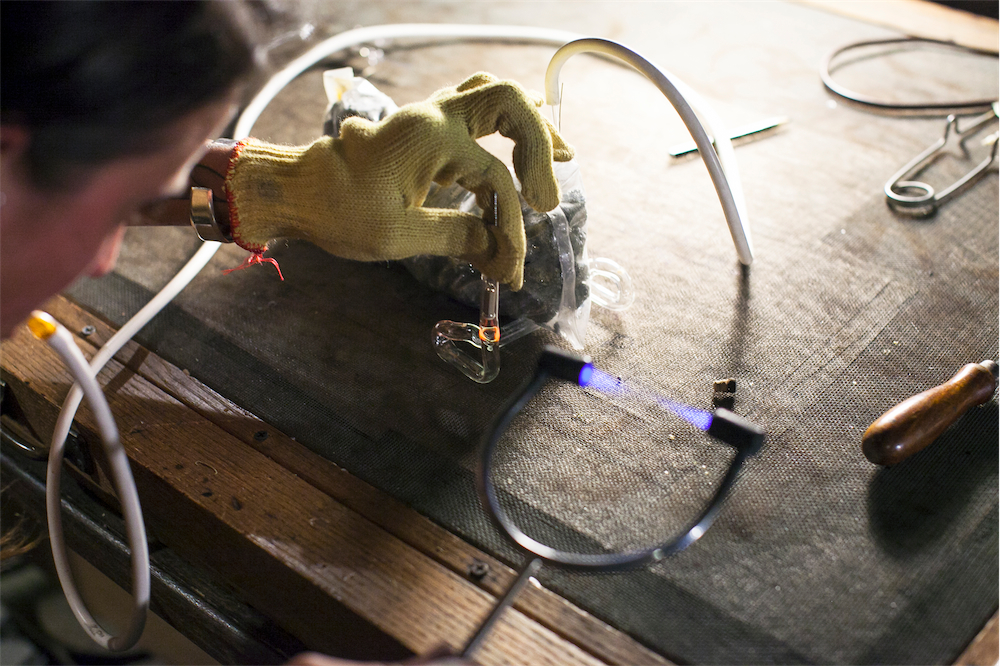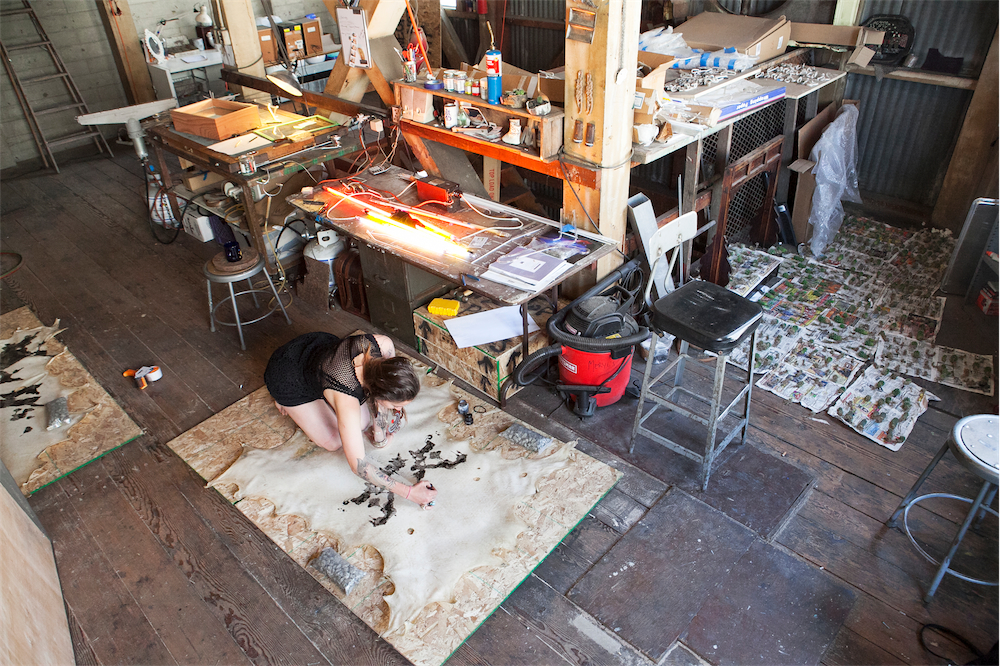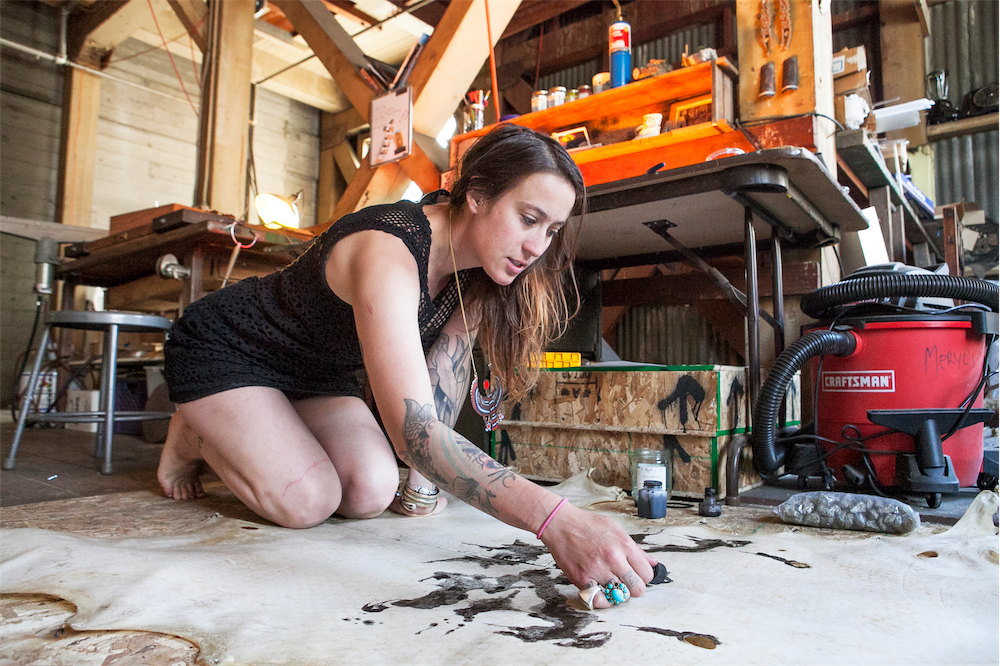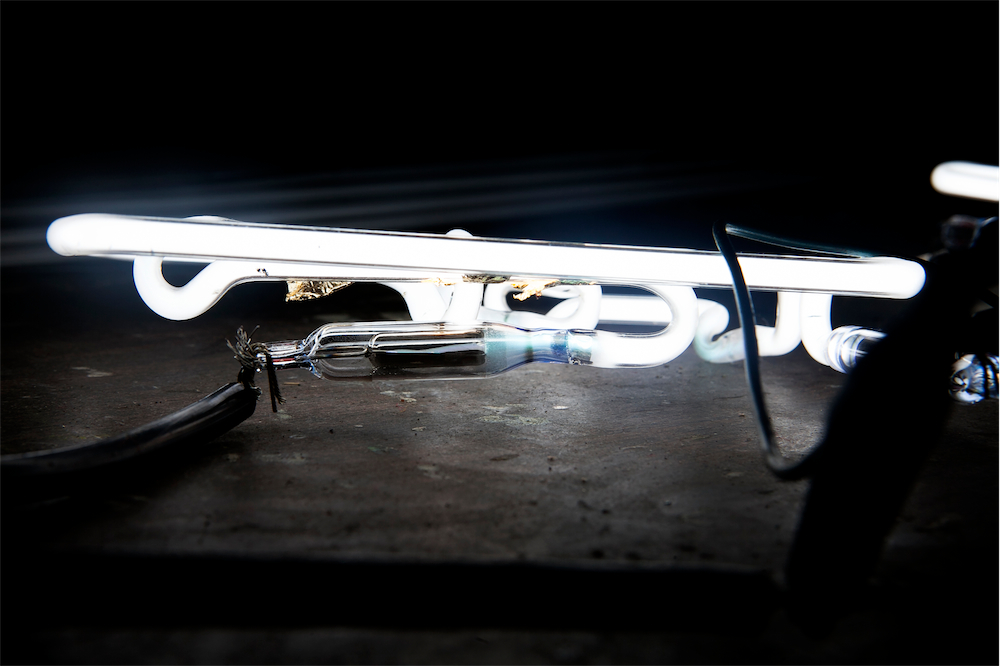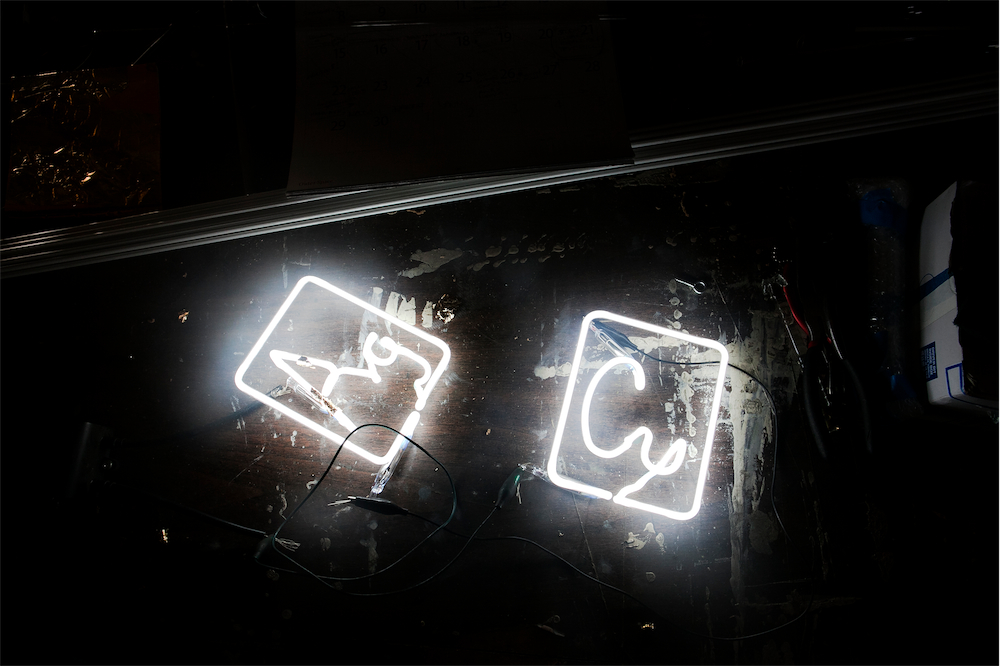San Francisco based multi-disciplinary artist Meryl Pataky‘s work first caught our eye a couple of years back with her unique use of neon.
Her solo exhibition The Golden Hour is set to open at SF’s Shooting Gallery on Saturday July 12th where she further explores her fascination with all things elemental, using helium gases within the neon works, iron in the framing and staging of the artworks, carbon within her rorschach deer hides and precious periodic elements Gold, Copper and Silver, which are formed during supernova, throughout this cosmically themed body of work.
We recently met up with Meryl when visiting San Francisco and wanted to find out more about her process-led work, so we asked a few questions.
Studio photography and video below by Brock Brake.
Arrested Motion (AM): I’m familiar with he golden hour as a term used by photographers for the first hour after sunrise. Soft, diffused and warm light prevails in this time. What does the term the golden hour mean to you and when is your own golden hour?
Meryl Pataky (MP):To me, the golden hour is during sunset. I was told by a photographer. Haha. But, during both times, the sky puts out the most beautiful colors and patterns. It’s amazing that the sky can go from blue to a burning orange with pinks, yellows and reds. Sunrises give softer colors and sunsets more saturated. I would be willing to bet that everyone has experienced either a sunrise or sunset that has blown them away and stayed with them as a meaningful memory. It’s an experience where we sit, detached from the goings on in our lives, the world, politics, money etc and just be with ourselves or companions. Some think about their humanity, what’s outside of our planet and the fact that we really are so small compared to what is going on “upstairs”. I call this, “meditation on the immeasurable.” The sunrise and sunset is a constant in our ever-changing lives – no matter what happens, the sun will always rise and always set (at least for the next couple billion years). And actually, an interesting fact that I’m sure most everyone knows is that the sun isn’t rising or setting. It’s our Earth’s rotation that gives the illusion that the sun is rising or lowering. The occurrences get their name from generations of people who did not know any better about our planet’s cycles and truly believed that the sun was moving above or below the horizon….and that the Earth was flat. But, we still use these names because, I mean, what else would we call it?
AM: Your work carries a heavy influence from nature, particularly the elemental based approach you use throughout the differing mediums you adopt. You are widely known for your neon work, which of course is totally element based. Which came first for you? The neon itself or did your elemental direction lead you to glass and gas?
MP: No actually the neon and all the other materials came first. My varying crafts and my obsession with acquiring knowledge of all of them, their physical and scientific properties, came first. Once neon and its science were introduced into my toolbox, so to speak, I realized how much of the periodic table I was using all the time. I went crazy in depth researching not only the scientific histories of each material (or element) but also the cultural histories and implications of those materials. They all came from a massive star explosion billions of years ago that created our galaxy and its solar systems and provided meaningful materials for human civilizations throughout our time.
AM: And there is a cosmic theme to the whole exhibition right? Tell us a little more about your thought process behind the show…
MP:It’s all about the cosmos! The show is about the sun, or all stars. Stars are furnaces that create elements starting from lighter elements like gases (helium, neon, oxygen) and then eventually heavier elements like carbon and iron. There are a ton of elements in between. They create these elements from a process called nuclear fusion. Elements fuse to create other elements in high heat and energy environments only known in stars. These “beings” are the most badass things in the universe. Their ongoing fusion process puts out the equivalent to 100 H bombs a second. They are the womb of everything we know and we are all made of stardust. This show is an homage to that and an invitation for the viewer to really think about what that might mean to them. All of neon tubing in the show (with some exceptions) are filled with Helium gas that puts out a warm peach color. The reason for this is that Helium is the first result in all stars’ fusion process – hydrogen fuses to helium. The steel frames in my work are comprised of iron and carbon, the heavier metals produced in a star. I have made three more “neon” periodic elements, this time precious metals gold, silver and copper. These elements are only forged during the incredibly energetic blast of a supernova giving them their name “precious”. I have a panel of plants that produce oxygen and deer hides and inks comprised of carbon and a panel of pyrite (fools gold which represents the sun in many ways) whose chemical compound is FeS2 (Ferric Sulfate or Iron and Sulfur). There is spiritual and psychological imagery present in the show as well with Rorschach and Tarot references.
AM: There’s a level of humor in your work, which personally I really appreciate, yet you still obviously take your work very seriously. Do you think being able to find a balance is important? So much art can be taken at face value without understanding it’s background I guess?
MP:SO much artwork is considered (and purchased) at face value. More art would touch more people if their concepts were shared or considered, not to say that there isn’t art that does. I am really drawn to conceptual art and my inspirations are very conceptual creators. I feel like art should say something, but that’s just me. When you make idea based art, you are thinking more about how your materials, process and imagery drive that idea and just think more about your materials in general, it seems tome. In terms of balance, yes, balance is important to every aspect of life and art with some of the scales tipped from time to time and that’s okay. Humor is a great way to talk about serious things. As an example, some neon work I created with Kurt Vonnegut quotes. Kurt Vonnegut had a way of talking about life and death (and the ugliest sides of humanity) so comically and ironically that it drove the point home more efficiently than taking the serious route.
AM: I understand that you studied sculpture for your degree. How did you first get into working with neon? It’s not the most accessible of mediums, and from what I understand it’s pretty unforgiving….
MP:I went to the Academy of Art for Sculpture and took the neon class with Bill Concannon, a Crockett based neon sign maker and industry professional for decades. He’s become my mentor after I finished school and we still work closely. It’s pretty hard, yea. There is still so much I don’t know and I’ve been doing it for five years. That’s what makes it a good fit for me, it is constantly teaching me something about myself and itself, it’s a relationship. It says fuck you Meryl and I say FUCK YOU GLASS! I suppose I’m a little pushy (pause for laughter for those that know me) and it’s good to have an outlet sometimes with your materials instead of in your personal life. My materials and the resistance they provide me teach me a lot about myself. When I treat it nicely and practice patience, tolerance and zen, it treats me nicely in return.
AM: Can you tell us a little about the process of making one of your neon works? Maybe give us a little creative background to one of the pieces in the show…
MP:The first is development of the idea which involves research (concepts and materials), a bit of engineering in some cases, drafting patterns for the glass. Drafting a pattern is a hand made scale pattern of the glass piece. You bend directly on the pattern, bend for bend to make up the lettering or design. Neon is bent in specialty fires that provide either a long “ribbon” fire or a cross-fire set up where tips are facing each other and you heat the glass in between where the two points cross. In the case of my succulent panel, I did an incredible amount of research on growers and suppliers, living walls and their construction and the meaning behind the imagery of the sword I am using and how that relates to the plants themselves. Succulents are resilient plants, thriving on the sun for light, producing oxygen (an element) creating cycles. The image of the sword comes from the Tarot’s Ace of Swords. It’s an upright sword that represents victory over challenges, resilience and power. It also reminds us there are always double edges and when there are ups, there are downs. When there are beginnings there will also be ends. The sun will always rise and it will always set. We evolve and take the bad and turn it into good if we want to survive. Survival of the fittest. Succulents have evolved to survive in harsh environments, like deserts. The overall mood/environment/aesthetic of the show is meant to remind you of a rocky earth, desert.
AM: I imagine your workspace is part studio, part workshop, and part magician’s lair… Can you elaborate a little about your working environment?
MP:Well for example, I am sitting in my studio answering these questions and there is super loud grinding and banging going on downstairs in a studio mate’s metal shop. It is a big building with huge open spaces, about 20 artists – painters, sculptors, machinists and jewelers. There is a lot going on here. I’ve got my equipment mixed in with some plants, little collections in mason jars (bones, bullet shells), some of my artwork is displayed, a big red leather lazy-boy and some cool old movie theater chairs. It’s a comfortable place to hang out and to work.
AM: And do you share the space with anyone or do you work alone? What’s the typical studio grind / routine for you?
MP:I have a whole floor that I share with two jewelers and my man who has his photography studio in the space. There really isn’t anything typical or routine about my days – one day I have to sit at the computer and do research, others I’m gluing pyrite rocks to panels, others I’m drawing and drafting, some I bend glass, some I need to fill large vats with water and soak deer hides, sometimes I have to build a crate and sometimes you’ll find me in the driveway with a tank and torch and a respirator heating up test solutions for silvering glass. I suppose one routine would be to get in as early as I can and leave as late as possible. I put in long hours. Another is the morning walk to the studio with my guy before our daily hustle, I always look forward to that.
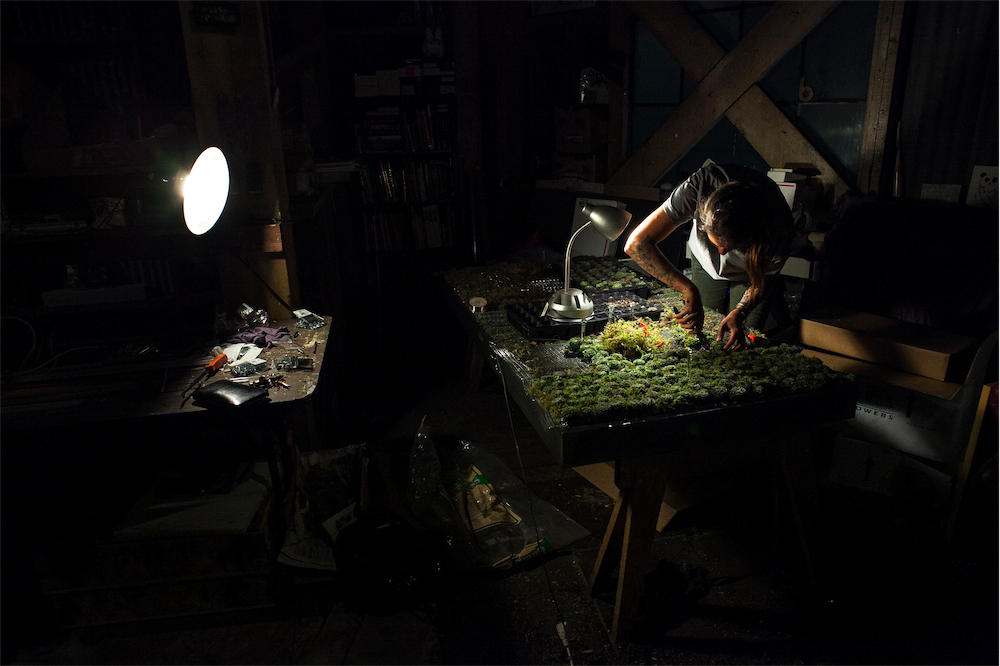
AM: You also make jewelry and your own paper too. Obviously very different processes to the neon work. What compels you to use these opposing technologies? It’s almost a total duality, with neon being seen as very ‘tech’ and paper and jewelry historically being some of the oldest creative practices…
MP:My compulsion comes from an intense desire for complete knowledge of any and all material there is and I think it’s important, when working with materials that provide resistance and sometimes frustration, to work with a gushy paper pulp and take a break, it’s super nice. Otherwise, one could go crazy or, at least I would.
AM: Your output seems to be very thematically based with distinct bodies of work from show to show. Where do you see your next direction going?
MP:I would like to start using stained glass and mirroring techniques combined with neon next. I’m experimenting with silver nitrate and sodium hydroxide to create a silvering solution so I can mirror my own glass. I would most likely start on some sort of collection like that next.
AM: Many thanks for taking the time out to answer our questions Meryl. Good luck with the show!
MP:Thank you thank you – love and light!




